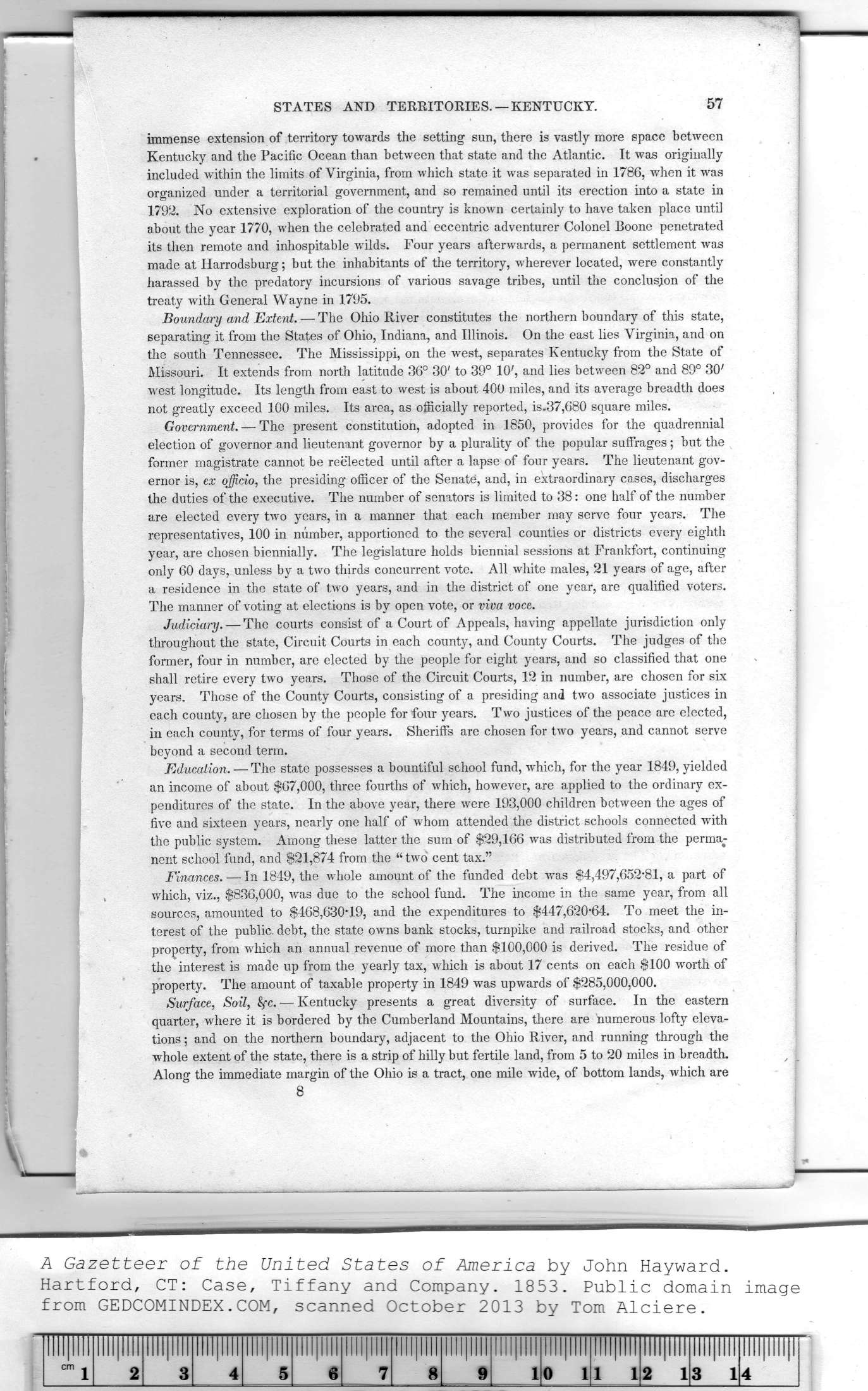|
|
Note: Ctrl and + increases the font size of the text below, Ctrl and - decreases it, and Ctrl and 0 resets it to default size.
STATES AND TERRITORIES. — KENTUCKY. 57
immense extension of territory towards the setting sun, there is vastly more space between
Kentucky and the Pacific Ocean than between that state and the Atlantic. It was originally
included within the limits of Virginia, from which state it was separated in 1786, when it was
organized under a territorial government, and so remained until its erection into a state in
1792. No extensive exploration of the country is known certainly to have taken place until
about the year 1770, when the celebrated and eccentric adventurer Colonel Boone penetrated
its then remote and inhospitable wilds. Four years afterwards, a permanent settlement was
made at Harrodsburg; but the inhabitants of the territory, wherever located, were constantly
harassed by the predatory incursions of various savage tribes, until the conclusion of the
treaty with General Wayne in 1795.
Boundary and Extent. — The Ohio River constitutes the northern boundary of this state,
separating it from the States of Ohio, Indiana, and Illinois. On the east lies Virginia, and on
the south Tennessee. The Mississippi, on the west, separates Kentucky from the State of
Missouri. It extends from north latitude 36° 30' to 39° 10', and lies between 82° and 89° 30'
west longitude. Its length from east to west is about 400 miles, and its average breadth does
not greatly exceed 100 miles. Its area, as officially reported, is.37,680 square miles.
Government. — The present constitution, adopted in 1850, provides for the quadrennial
election of governor and lieutenant governor by a plurality of the popular suffrages ; but the
former magistrate cannot be reelected until after a lapse of four years. The lieutenant gov-
ernor is, ex officio, the presiding officer of the Senate, and, in extraordinary cases, discharges
the duties of the executive. The number of senators is limited to 38: one half of the number
are elected every two years, in a manner that each member may serve four years. The
representatives, 100 in number, apportioned to the several counties or districts every eighth
year, are chosen biennially. The legislature holds biennial sessions at Frankfort, continuing
only 60 days, unless by a two thirds concurrent vote. All white males, 21 years of age, after
a residence in the state of two years, and in the district of one year, are qualified voters.
The manner of voting at elections is by open vote, or viva voce.
Judiciary. — The courts consist of a Court of Appeals, having appellate jurisdiction only
throughout the state, Circuit Courts in each county, and County Courts. The judges of the
former, four in number, are elected by the people for eight years, and so classified that one
shall retire every two years. Those of the Circuit Courts, 12 in number, are chosen for six
years. Those of the County Courts, consisting of a presiding and two associate justices in
each county, are chosen by the people for four years. Two justices of the peace are elected,
in each county, for terms of four years. Sheriffs are chosen for two years, and cannot serve
beyond a second term.
Education. — The state possesses a bountiful school fund, which, for the year 1849, yielded
an income of about $67,000, three fourths of which, however, are applied to the ordinary ex-
penditures of the state. In the above year, there were 193,000 children between the ages of
five and sixteen years, nearly one half of whom attended the district schools connected with
the public system. Among these latter the sum of $29,166 was distributed from the perma-
nent school fund, and $21,874 from the “ two cent tax."
Finances. — In 1849, the whole amount of the funded debt was $4,497,652-81, a part of
which, viz., $836,000, was due to the school fund. The income in the same year, from all
sources, amounted to $468,630-19, and the expenditures to $447,620-64. To meet the in-
terest of the public, debt, the state owns bank stocks, turnpike and railroad stocks, and other
property, from which an annual revenue of more than $100,000 is derived. The residue of
the interest is made up from the yearly tax, which is about 17 cents on each $100 worth of
property. The amount of taxable property in 1849 was upwards of $285,000,000.
Surface, Soil, £fc. — Kentucky presents a great diversity of surface. In the eastern
quarter, where it is bordered by the Cumberland Mountains, there are numerous lofty eleva-
tions ; and on the northern boundary, adjacent to the Ohio River, and running through the
whole extent of the state, there is a strip of hilly but fertile land, from 5 to 20 miles in breadth.
Along the immediate margin of the Ohio is a tract, one mile wide, of bottom lands, which are
8
|
Illllllll |
|
Illllllll |
|
|
|
llll llll |
llll|llll|llll|llll |
llll|llll |
Illllllll |
Illllllll |
Illllllll |
|
cm j |
2 3 |
4 |
5 |
6 |
7 |
8 |
9 1 |
0 1 |
1 1 |
2 1 |
3 1 |
|
